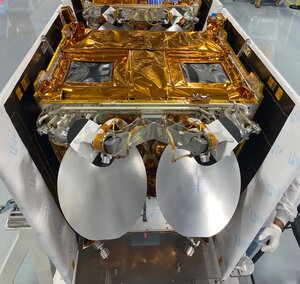More missions for Europeans astronauts
The Andromède ‘taxi’ flight last October with ESA astronaut Claudie Haigneré of French nationality as Flight Engineer, was the prelude to a series of missions to the International Space Station using the Russian Soyuz spacecraft.
The Andromède ‘taxi’ flight last October with ESA astronaut Claudie Haigneré of French nationality as Flight Engineer, was the prelude to a series of missions to the International Space Station using the Russian Soyuz spacecraft.
ESA and Rosaviakosmos signed an agreement in May 2001 which paved the way for such European missions using so-called ‘taxi’ flights – where crews will initially stay on the Space Station for up to three weeks and in the future for between three and four months on long-duration increment flights.
The agreement represents an important step in the development of operational expertise for Europe’s astronauts before intensive use of the Space Station for scientific research, Earth observation, materials science and human physiology experiments commences with the launch of the Columbus laboratory in 2004.
ESA has two astronauts scheduled for further missions to the Space Station over the coming months. In October, ESA astronaut Frank De Winne, of Belgian nationality, will be a Flight Engineer on board a Soyuz taxi mission and next Spring 2003 Sweden’s first astronaut Christer Fuglesang will fly on a Space Shuttle mission.
Frank De Winne, whose mission will follow a similar profile to Roberto Vittori’s, will also be involved in a substantial scientific experimental programme, including experiments led by Belgian scientists.
During the STS-116 flight, Fuglesang is scheduled to conduct Extra Vehicular Activities (EVAs) or ‘spacewalks’ outside the Space Station.
The major objectives of his Shuttle mission will be to add new segments to the Space Station’s truss section, carry the Expedition 8 crew into orbit and return with the three Expedition 7 crew members.















 Germany
Germany
 Austria
Austria
 Belgium
Belgium
 Denmark
Denmark
 Spain
Spain
 Estonia
Estonia
 Finland
Finland
 France
France
 Greece
Greece
 Hungary
Hungary
 Ireland
Ireland
 Italy
Italy
 Luxembourg
Luxembourg
 Norway
Norway
 The Netherlands
The Netherlands
 Poland
Poland
 Portugal
Portugal
 Czechia
Czechia
 Romania
Romania
 United Kingdom
United Kingdom
 Slovenia
Slovenia
 Sweden
Sweden
 Switzerland
Switzerland

























